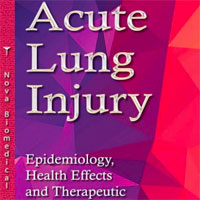Tag: inflammation
Pathological Inflammation in Patients with COVID-19
The COVID-19 pandemic caused by infection with SARS-CoV-2 has led to more than 200,000 deaths worldwide. Several studies have now established that the hyperinflammatory response induced by SARS-CoV-2 is a major cause of disease... read more
Is COVID-19 ARDS?
Acute respiratory distress syndrome (ARDS) is a heterogeneous disease. It presents with a wide range of severity, varying degrees of hypoxemia and varying degrees of pulmonary mechanical impairment. Failure of hypoxemic vasoconstriction... read more
An Interview With an Italian Intensivist on the COVID Experience in Italy
The current COVID-19 crisis has a huge human impact. Clearly cardiovascular issues have a central role in management and, unfortunately, in adverse outcomes. We are continually struggling to understand risks and management... read more
Respiratory Drive in the ARDS: Pathophysiology, Monitoring, and Therapeutic Interventions
Neural respiratory drive, i.e., the activity of respiratory centres controlling breathing, is an overlooked physiologic variable which affects the pathophysiology and the clinical outcome of acute respiratory distress syndrome... read more
Which Component of Mechanical Power is Most Important in Causing VILI?
Repeated applications of tidal energy inflict lung damage (VILI) when stress and strain exceed the limits of tissue tolerance. Inflation work and energy are the products of pressure and volume, which are loosely associated... read more
Potential Therapy for Improving Sudden Cardiac Arrest Resuscitation Outcomes
The severity of cardiogenic shock following asystolic cardiac arrest is dependent on the length of cardiac arrest prior to cardiopulmonary resuscitation and is mediated by myocardial stunning resulting from mitochondrial... read more
Aldosterone Synthase in Peripheral Sensory Neurons Contributes to Mechanical Hypersensitivity during Local Inflammation in Rats
Local production of aldosterone by its processing enzyme aldosterone synthase within peripheral sensory neurons contributes to ongoing mechanical hypersensitivity during local inflammation via intrinsic activation of neuronal... read more
Time to Recognition of Sepsis in the Emergency Department Using Electronic Health Record Data
Systemic inflammatory response syndrome and Sequential Organ Failure Assessment initially identified distinct populations. Using systemic inflammatory response syndrome resulted in earlier electronic health record sepsis... read more
Enteral Nutrition Can Be Given to Patients on Vasopressors
Most all recent studies show Enteral Nutrition (EN) can be delivered safely to patients on vasopressors. In fact, many studies show an outcome benefit of early EN (EEN) in ICU patients who are receiving vasopressors. It... read more
Serum Protein Changes in Pediatric Sepsis Patients Identified with an Aptamer-Based Multiplexed Proteomic Approach
The serum protein changes identified with the aptamer-based multiplexed proteomics approach used in this study can be useful to distinguish between sepsis and noninfectious systemic inflammation. A cohort of 40 children... read more
Endogenous Agmatine Metabolism Correlated with the Progression of Sepsis
Supplemental exogenous agmatine could ameliorate the lipopolysaccharide-induced systemic inflammatory responses and multiple organ injuries through the 2 receptor">imidazoline I2 receptor-ribosomal S6 kinase 2-nuclear factor-κB... read more
Correlation Among Endothelial Injury, Organ Dysfunction, and Several Biomarkers in Sepsis Patients
Protein C was superior for the prediction of organ dysfunction after 7 days of ICU treatment when compared with other biomarkers of endothelial function, inflammation, and coagulation. C-reactive protein (CRP) and white blood... read more
Abnormalities in the Host Immune Response During Hospitalization for Sepsis
In this cohort study of 483 patients who survived hospitalization with sepsis at 12 US hospitals, 25.8% had elevated high-sensitivity C-reactive protein levels (a marker of inflammation) at 3 months, 30.2% at 6 months, and... read more
Acute Lung Injury: Epidemiology, Health Effects and Therapeutic Treatment Strategies
ALI/acute respiratory distress syndrome (ARDS) is characterized by diffuse alveolar damage, alveolar capillary leakage, lung edema, neutrophil-derived inflammation, and surfactant dysfunction. These changes lead to clinical... read more

Assessment of immune organ dysfunction in critical illness
Critical illness may often induce persisting injury-associated immunosuppression with adverse effects on relevant patient-centered outcomes. However, despite the key task of ICU physicians to detect, monitor, and follow up... read more
Mechanical Ventilation in Patients with Acute Ischemic Stroke
Although there are no specific data regarding the effect of respiratory management on stroke patients' outcomes, specific ventilator strategies in this population could potentially improve neurologic outcome and prevent respiratory... read more
Long-term Cognitive Impairment After ARDS
Reducing the practical burden of cognitive recovery following critical illness depends crucially on understanding the links between brain injury and lung injury. New deficits in learning and memory, and new development... read more
Vitamin C for Sepsis
Dr. Alpha A. Fowler of Virginia Commonwealth University presented findings from the CITRIS-ALI trial that studied the role of vitamin C in patients with septic ARDS. The findings were presented @ESICM in Berlin and have just... read more
Corticosteroids for Children with Septic Arthritis
Researchers conducted a review of the effects of corticosteroids given in addition to antibiotics to children with septic arthritis. Evidence was sought until April 2018. After searching for all relevant studies, reviewers... read more
Effect of Vitamin C Infusion on Organ Failure in Patients With Sepsis and ARDS
In this preliminary study of patients with sepsis and Acute Respiratory Distress Syndrome (ARDS), a 96-hour infusion of vitamin C compared with placebo did not significantly improve organ dysfunction scores or alter markers... read more
Cognitive Outcomes After Critical Illness
Persistent cognitive impairment is a major complication of critical illness. Our knowledge of this problem remains incomplete. Collaborative research is indispensable to improve our understanding of this disabling sequel... read more
Accuracy of Quick Sequential Organ Failure Assessment Score to Predict Sepsis Mortality
Overall, quick Sequential Organ Failure Assessment score outperforms systemic inflammatory response syndrome in predicting sepsis outcome, but quick Sequential Organ Failure Assessment score has relative strengths/weaknesses... read more









